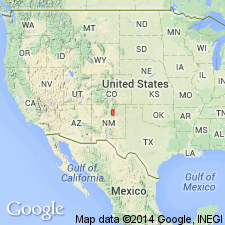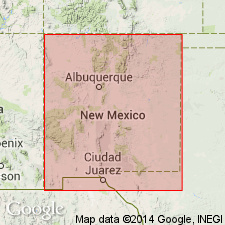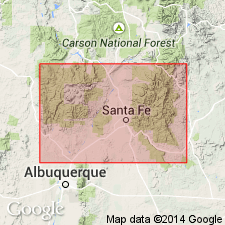
- Usage in publication:
-
- Cowles member*
- Modifications:
-
- Named
- Dominant lithology:
-
- Siltstone
- Conglomerate
- Shale
- Limestone
- Sandstone
- AAPG geologic province:
-
- Many basins
Summary:
Named as uppermost of three members of Tererro formation (all new). A 57-ft-thick type section measured in and above abandoned quarry on road to Winsor Ranch, 0.2 mi south of Cowles (for which probably named), east side of Pecos River Canyon, San Miguel Co, NM. Consists of: 1) basal notch-forming light-gray limestone-pebble conglomerate, marly shale, and thin, very fine grained silty calcarenite, 2-3 ft thick. This grades into; 2) ledge-forming yellowish-brown or gray, fine- to medium-grained cross-bedded calcarenite, 35 ft thick; and 3) poorly exposed, thin, yellowish-gray to olive silty limestone and interbedded silty, marly shale, 20 ft thick, at top. Where difficult to differentiate, differs from unconformably underlying Manuelitas member of Tererro in that chert is uncommon, beds are not involved in collapse (no karst topography), and the calcarenite is finer grained. Underlies Sandia formation unconformably (contact is concealed). Present in most of the southern Sangre de Cristo Mountains (except along western margin, where rocks have been cut out or concealed by overthrust rocks of Precambrian age) in Taos, Mora, San Miguel, and Santa Fe Cos, NM, in San Luis, Las Vegas-Raton, Palo Duro, and Estancia basins. In southeast part of Sangre de Cristo Mountains, Cowles has become completely eroded. Irregularly thickens and thins due to pre-Pennsylvanian or Early Pennsylvanian erosion. Measured sections. Is of Early Mississippian age.
Source: GNU records (USGS DDS-6; Denver GNULEX).

- Usage in publication:
-
- Cowles Member
- Modifications:
-
- Age modified
- AAPG geologic province:
-
- San Luis basin
- Palo Duro basin
- Las Vegas-Raton basin
- Estancia basin
Summary:
Age of Tererro Formation and its (ascending) Macho, Manuelitas, and Cowles Members modified. Age of Manuelitas Member of Tererro given by Baltz and Read (1960) as Early Mississippian, based on faunule found in Manuelitas Member; in this report, species of ENDOTHYRA have been collected from all three members of Tererro, studied by Zimmerman of Sun Oil Co. Research Laboratory, and found to be definitely Meramecian age. Since none of the fossils (primarily brachiopods) listed by Baltz and Read (1960) were identified with certainty and were poorly preserved as well, the well-preserved endothyrid faunas of this report are believed to provide a more reliable indication of probable age. The entire Tererro Formation is therefore best considered to be of Meramecian (Late Mississippian) age, as previously proposed by Armstrong (1958), who studied endothyrid faunas from various Mississippian localities in northern NM. Tererro present throughout most of Sangre de Cristo Mountains (except along western margin, where rocks have been cut out or concealed by overthrust rocks of Precambrian age) in Taos, Mora, San Miguel, and Santa Fe Cos, NM, in San Luis, Las Vegas-Raton, Palo Duro, and Estancia basins. Present in Rincon, Santa Fe, Taos, and western part of Truchas Ranges. Geologic map, measured sections.
Source: GNU records (USGS DDS-6; Denver GNULEX).

- Usage in publication:
-
- Cowles Member*
- Modifications:
-
- Age modified
- Biostratigraphic dating
- AAPG geologic province:
-
- Palo Duro basin
- Las Vegas-Raton basin
Summary:
Age of Cowles Member of Tererro Formation (revised, age modified) of Arroyo Penasco Group (raised in rank to group in this report) modified from Meramecian to early Chesterian (Late Mississippian). "The presence of primitive NEOARCHAEDISCUS and of ZELLERINA clearly indicates that the formation [Member] is younger than Meramecian and should be regarded as early Chesterian age equivalent. There is therefore no proof of the existence of Ste. Genevieve fauna between the Manuelitas Member [of Tererro] and the Cowles Member." [The Cowles Member is shown on chart to contain Zone 16i microfossils.] Cowles rests on Manuelitas Member of Tererro with paraconformable contact everywhere in Sangre de Cristo Mountains; Cowles is only present in Sangre de Cristo Mountains, Mora and San Miguel Cos, NM, Las Vegas-Raton and Palo Duro basins. Top of Cowles is eroded everywhere and unconformably overlain by Pennsylvanian clastic rocks. Apparent thickness is .5 m at Turquillo, 2.5 m at Rio Pueblo, 3 m at Mora Gap, 4.5 m at Coco City, 10 m at Jack's Creek, and 10.1 m at Lujan Canyon [Rincon Range]. "The paleogeography of the Cowles Member in the Sangre de Cristo Mountains is difficult to assess as the unit was deeply gouged by overlying units." Good lithologic description, discussion of depositional cycles, regional correlation chart.
Source: GNU records (USGS DDS-6; Denver GNULEX).
For more information, please contact Nancy Stamm, Geologic Names Committee Secretary.
Asterisk (*) indicates published by U.S. Geological Survey authors.
"No current usage" (†) implies that a name has been abandoned or has fallen into disuse. Former usage and, if known, replacement name given in parentheses ( ).
Slash (/) indicates name conflicts with nomenclatural guidelines (CSN, 1933; ACSN, 1961, 1970; NACSN, 1983, 2005, 2021). May be explained within brackets ([ ]).

